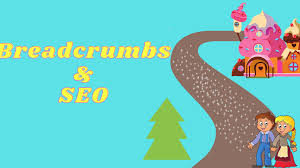One of the website elements that Google likes is breadcrumbs. Google is emphasizing the importance of breadcrumbs in all its SEO related documents and guides.What are breadcrumbs and why do they speak for SEO?
The reason is simple: breadcrumb trails have something for both search engines and users.
Search engines use them to get better information about how your website is structured and they help users to make the website easier.
Breadcrumbs are an essential part of just about every good website. These small navigational aids not only tell people where they are on your site, but they also help to tell Google how your site is structured. Since it has such advantages, it means a lot to add these ‘helpful little dots’ to a website. Before jumping into the technicalities, let’s know what breadcrumbs are:
What are breadcrumbs?
Breadcrumbs are links that allow users to track and analyze the path from the page they are currently viewing to the homepage of a website. It appears at the top of the web page and shows the navigation structure of the website.
They can also add context to the innermost of the pages and reduce many negative factors that can improve the user experience of the website.

Breadcrumbs type
There are different types of breadcrumbs, the three most common are:
1. Breadcrumbs: hierarchically based
These are the most common type of breadcrumbs. It tells the user where they are in the site structure and how many steps they take to return to the homepage. for example:
Home> Blog> Category> Post Name
2. Breadcrumbs: Attribute-Based
Attribute-based breadcrumbs are most commonly seen on e-commerce websites when searched by a user. The breadcrumbs path is made up of product attributes. for example:
Home> Product Categories> Gender> Size> Color
3. Breadcrumbs: History-based
History-based breadcrumbs are ordered on a website as ordered by the user. Think of them as an alternative to the internet history bar. for example:
Home> Previous page> Previous page> Current page
Benefits of using breadcrumbs for SEO
1. Breadcrumbs improve UX
Breadcrumbs make it easy for users to navigate the website – and they encourage users to browse other sections of the site.
For example, you want to know more about Nestlé.
You go to their site and end up on the Nestlé company history page.
2. Improve Site Ranking
Breadcrumbs are great for UX, but they also please Google.
If you are doing both, you are dreaming SEO, are you rich?
According to Google, they use breadcrumbs to categorize and reference content.
Back in 2018, Google added breadcrumbs to the results pages, making them more important than ever.
3. Keep people longer
The bounce rate may not be a direct ranking factor, but it can still help SEO directly.
In addition, a high buoyancy rate may indicate problems with UX – problems that can help solve breadcrumbs.
How do you add breadcrumbs to your site?
There are many variables involved in implementing breadcrumbs on your site.
Some examples include:
- Type of your site
- Your site’s content management system (CMS)
- Your kind of breadcrumbs
Depending on your website, adding breadcrumbs can be as simple as installing a widget or add-on on your site. However, at other times, it can be hours of work from a development team to design and launch the right structure for your website.
Breadcrumbs seo seo best practices
Optimize your breadcrumbs for SEO, you need to follow these simple rules:
Make sure breadcrumbs are enabled and visible to users.
This may sound obvious but many web designers tend to hide the breadcrumb trail because they think it does not coincide with the design.
it is not true. Look at the first example above and see how useful the breadcrumb trail is on the Rolex website (and it sounds great too).
Make sure breadcrumbs are mobile friendly.
If you decide to make breadcrumbs visible on mobile devices, make sure the font size is large enough so that the link is easily clicked. It is a common practice to hide breadcrumbs on mobile or make them like buttons.
When to Use Breadcrumbs?
Breadcrumbs are used for large websites (eg e-commerce) and websites that have a number of pages used n ‘. They should not be used for single-level websites, where there is no logical hierarchy of pages or any group.
Breadcrumb navigation for the creation of a sitemap is the best way to determine how much a website will benefit. This will be a diagram representing the navigation architecture of the website.
It is also important to analyze if breadcrumbs will improve a user’s navigation ability between different categories on a website.
Breadcrumb navigation is an additional feature, and should not play any role in reducing the effectiveness of the primary navigation menu. This is simply a convenience feature that allows users to find where they are and helps them navigate through the website easily, just like a secondary navigation scheme.
Features of breadcrumbs
- Breadcrumbs can be applied to any page: static (node / 1) or dynamic (node /% NID).
- It is possible to load references from URLs and use them as tokens for breadcrumb paths or headings
- Import and export breadcrumbs (supports single operations, features and Ctools bulk exports)
- Breadcrumbs can be cloned to save time when creating navigation
- The module provides rich snippet support for breadcrumbs (RDFa and microdata)
- Breadcrumbs can be hidden if they contain only one element.
- It is possible to disable and enable breadcrumbs
- All breadcrumb titles are translatable
- Usable interface
Conclusion:
Breadcrumbs trails are good for the user experience, they make your search snippets look better and Google loves them.
Feel free to contact us today, 1WebLab is a well-known SEO company in Delhi Laxmi Nagar, India. It is our responsibility, together with our development and design team, to make the websites we work on accessible to everyone.
